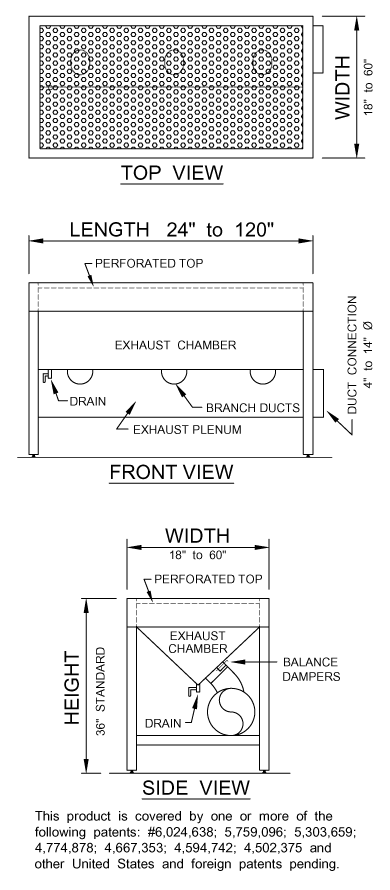 |
How to determine if heavier than air:
-
The density of a gas is roughly proportional to its
molecular weight. Air has an average molecular weight
of about 29 gl/mol, so any gas with a molecular
weight greater than 29 gl/mol will be denser than air.
The way to calculate the molecular weight of any
formula is to add the atomic weight of all the atoms
in the formula.
-
For example: Hydrogen Chloride, HCI. A hydrogen
atom has a mass of 1.008 AMU and a chlorine atom
has a mass of 35,453 AMU. The molecular weight of
HCI is 36.461 gl/mol, the sum of the atomic weight of
hydrogen and chlorine.
Standard Features:
-
Epoxy painted steel frame, legs and chamber. (Standard light gray,
other colors available.)
-
Perforated top: 1/4" diameter holes 3/8" staggered centers.
(Standard 14 gauge SS 304)
-
Sloped bottom to 1/2" drain valve
-
Balance dampers
-
Duct: painted 22 gauge galvanized steel.
-
Capture velocity: 40 to 150 fpm. (Typically 50 fpm for heavier than air gases)
(Typically 100 fpm for particulate)
-
Pressure drop: less than 0.5 in. w. g.
-
Legs have heavy duty leveling pads and vinyl boot.
Options:
-
Actuated exhaust damper or "on-off" switch.
-
Alternate working height
-
Frame, legs and / or chamber: SS 304 or SS 316
-
Perforated top: 14 gauge epoxy painted steel, SS 316, 1/8" PVC, CPVC or Polypropylene
-
Combination of solid and perforated top
-
6" wide rectangular duct for routing behind cabinets.
-
Three-sided containment barrier (Removable)
-
40% high capacity pleat filters (below perforated top)
|
|


